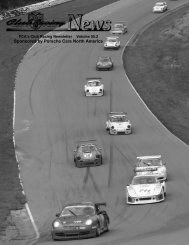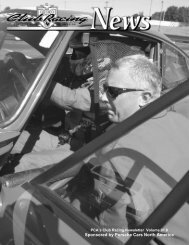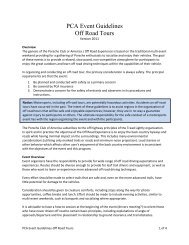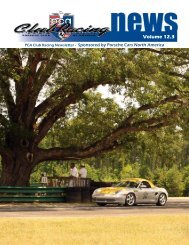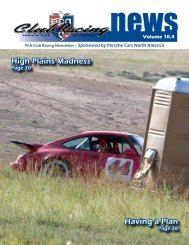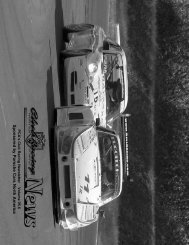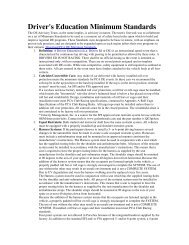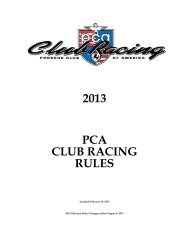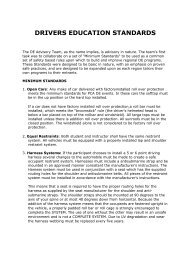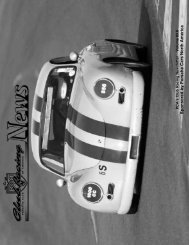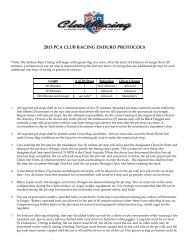2003, Volume 4 - Porsche Club of America
2003, Volume 4 - Porsche Club of America
2003, Volume 4 - Porsche Club of America
Create successful ePaper yourself
Turn your PDF publications into a flip-book with our unique Google optimized e-Paper software.
laps can take up to twice as much time to complete than green<br />
laps, so do the math on driver lap times. NASCAR drivers may<br />
pit under green at Infineon with great success, but it usually<br />
doesn’t work in PCA. Of course, the hardest part is determining<br />
early whether an incident will bring out a full-course caution<br />
or how long it will be (see communication), so you can get<br />
a clear(er) pit lane.<br />
Aside from the closed pit times, if you run a slow lap,<br />
for any reason, that <strong>of</strong>fers another occasion to pit. This saves<br />
you from adding another slow lap to the ones you will already<br />
incur on“in” and the “out” laps.<br />
Once you are in the pits, remind yourself that five<br />
minutes is eternally long. Always chat, in person or on the<br />
radio, with your crew or co-driver just before or once you<br />
arrive in the pits—to pass on valuable information before panic<br />
sets in. Go over what you want or need to do during the stop. If<br />
you are driving an unfamiliar car, or if the co-drivers will be<br />
handling the refueling, practice the driver change beforehand.<br />
And don’t forget to time the trips down pit lane. Know<br />
where the pit lane entry and exit gates are. Not only is every pit<br />
lane a different length, these trips could cost you 10-15 seconds<br />
if not accounted for as part <strong>of</strong> the five minutes. Don’t lollygag<br />
outside the gates either.<br />
For those running the first enduro on the schedule,<br />
you may not have much time to set up your pit area. Get there<br />
early and be prepared. Some tracks will not allow vehicles near<br />
the pit boxes, so have a golf cart or wagon. In addition to the<br />
mandatory and/or automotive necessities, bring the rulebook,<br />
water, sun block (or a canopy) and chairs.<br />
Communication and awareness<br />
Radios are extremely important and in lieu <strong>of</strong> that, pit<br />
boards. Knowing where you are, in comparison with your<br />
competitors is the single most important fact. Other useful<br />
topics include track conditions, incidents, lap counts, when to<br />
pit, car issues, fuel consumption, lap times, where the overall<br />
leader is and, most importantly, timing restarts. Most<br />
importantly, if you are sharing a pit—or have adjoining<br />
pits —talk to each other to avoid pit lane congestion.<br />
Have a game plan: Discuss, in simple steps, what is<br />
realistically expected from each crew member and<br />
driver —in relation to each person’s strengths, the track, the<br />
competitive match-up and your car’s capabilities.<br />
Fuel strategy<br />
Many teams fumble the refueling, if not the gas<br />
mileage calculations. If you go without refueling, that’s the<br />
easiest strategy—just fill the tank beforehand and go. After all,<br />
you may be able to drive an acceptable lap time already,<br />
without throwing in a task that may become cumbersome under<br />
pressure.<br />
Calculate fuel mileage during practice (but know<br />
you’ll use more out <strong>of</strong> sheer adrenaline). Read, memorize and<br />
follow the rules. But don’t get caught running out <strong>of</strong> gas. No<br />
matter what, always bring a spare jug <strong>of</strong> fuel to the pits.<br />
CRN July/August <strong>2003</strong><br />
9



